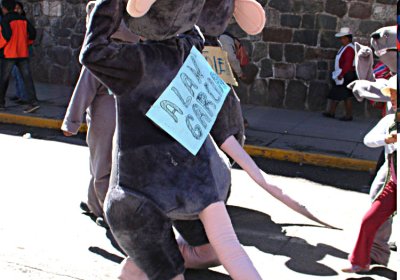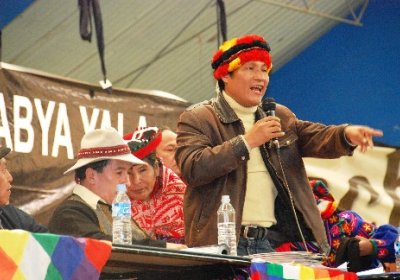Peruvian stocks lost a record 12% of their value as local and global investors jettisoned mining shares after left-leaning nationalist Ollanta Humala won the second round of Peru's presidential elections on June 5.
The multi-billion dollar plunge reflects the fear and hostility that “market forces” instinctively bear toward an expression of the popular will in “developing” resource-rich nations like Peru.
Humala defeated the right-wing candidate Keiko Fujimori with 51.3% of the vote. Keiko is the daughter of jailed ex-dictator Alberto Fujimori.
Peru
Corporate media outlets claim Peru’s mining boom is doing wonders for the country’s economy, creating opportunities and making everybody richer.
Quite a few Peruvians, mostly situated in the bubble-world of Lima’s wealthy areas, have been drinking the neoliberal kool-aid.
Someone must have forgotten to tell those troublesome recalcitrants out in the provinces that the despoliation of their lands is good for them.
Peruvians went to the polls to elect a new president on April 10.
In a first round result reminiscent of the 2006 election, the electorate has sent the previously languishing “left-nationalist” candidate Ollanta Humala (of the Gana Peru alliance) through to the presidential runoff on June 5.
As in 2006, Humala will face a candidate representing elite interests: Keiko Fujimori, the daughter of ex-president and architect of Peru’s neoliberal development model, Alberto Fujimori.
Only days before Peru’s general elections on April 10, three protesters were killed and dozens injured by firearm-wielding police near the southern city of Arequipa.
The protesters were taking part in a community uprising against the Tia Maria copper mine proposed by Mexican-based, US-funded Southern Copper. The company has one of the worst environmental track records of any mining company active in Peru.
Fearing that the mine would irredeemably contaminate local water, the residents of Islay took to the streets, despite realising it would put their lives at risk.
Opinion polls are predicting that the likely winner of the April 10 Peruvian presidential election will be Alejandro Toledo. The candidate of Possible Peru, Toledo was the neoliberal president from 2001-06.
After the narrow victory of the moderate left candidate Susana Villaran from Social Force in the Lima mayoral elections last year, it was predicted that the left’s prospects might improve nationally.
So far this has failed to materialise, owing partly to a redoubled effort by the elite and its foreign backers to promote Toledo.
In a joint statement on February 25, indigenous communities that make up the Native Federation of Madre de Dios River and Tributaries in south-eastern Peru rejected a military crackdown on illegal mining on their lands.
The statement said it was a “false solution to a problem that has social and economic roots”.
Environment minister Antonio Bracks authorised the operation in mid February —involving about 1000 police and infantrymen — to destroy illegal mining equipment including bombing of dredges.
Peruvian President Alan Garcia, who last year ordered the brutal massacre of protesting Amazonian tribespeople, has once again resorted to violence — this time in person.
Visiting Edgardo Rebagliati Hospital in Lima, on October 9, Garcia encountered 27-year-old Ricardo Galvez, who shouted “corrupt” at the president. Eyewitnesses say Garcia flew into an uncontrollable rage and forcefully struck the volunteer worker in the face.
Members of Garcia’s entourage landed follow up blows, knocking a defenceless Galvez to the floor where he was subjected to further mistreatment.
One of the greatest living exponents of Peruvian musica criolla (creole music), Eva Ayllon, performed at the Sydney Opera House on September 25. Finding my seat, I felt as if I’d walked into an exuberant family gathering full of animated conversation, laughter, waving and group photography.
Peru’s Amazonian indigenous people have announced the creation of their own political party and will contest the presidential elections in April 2011.
The indigenous people clashed with Peruvian President Alan Garcia’s government in 2009 to defend their ancestral lands in the largest indigenous uprising in recent history.
In Australia, the question of environmental protection has increasingly been linked to the need to reduce or contain the nation’s population level size. This is often tied to the argument that the high level of consumption in First World countries is unsustainable.
On June 1, part-Peruvian US actor and indigenous rights activist Q’orianka Kilcher was arrested for “disorderly conduct” after chaining herself to the White House fence while Peruvian President Alan Garcia met with US President Barack Obama.
Garcia refers to the Amazonian indigenous peoples of his country as barbaric savages. Kilcher had doused her body in black paint, symbolic of the oil killing the Amazon and its people.
The Peruvian capital of Lima, faced with rapidly rising costs of living, was the epicentre of the protests on July calling for fulfilment of social and wage agreements signed by the government on July 9. Although only one violent incident occurred, some 200 demonstrators were arrested.
- Previous page
- Page 6
- Next page







